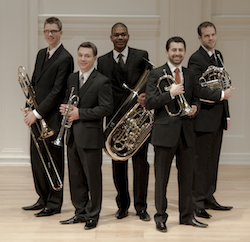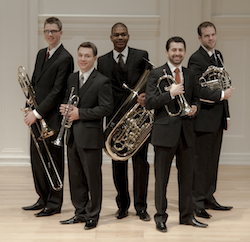
In the life of largely unknown ensembles, there’s that moment when the group has solidified in a way that its performances portend that future notoriety is almost a given. It can be likened to a garage band that plays at a club for the first time, where everyone in attendance has that “I was there when they were nobody” moment.
This was the undercurrent felt during a stellar performance by the Axiom Brass Quintet Wednesday evening. This fresh-faced quintet, which hails from Chicago — that great breeding ground for brass playing — was making its West Coast debut. The concert was the first of the 2013 New Millennium Concert Series, held at Sacramento State University’s Music Hall.
Looking crisp in their identical dress blacks and performing behind stands holding iPads instead of sheet music, this ensemble made a bold statement by the way they tackled a tricky assortment of works, some written for brass, others far from the brass realm.
The program veered from the Renaissance to new music, and showed off the talent of Brazilian trumpeter and cofounder Dorival Puccini Jr., trumpet player Colin Oldberg, trombonist Caleb Lambert, hornist Matthew Oliphant, and tubist Kevin Harrison. These musicians not only showed a capacity to engage their audience musically, they also weren’t afraid to engage it on a personal level in discussing the program. Their banter between works revealed a quirky, almost sarcastic demeanor.
Most engaging, and a highlight of the concert, was Puccini’s smart arrangements of works by Astor Piazzolla. Could the sensual and lurid allure of Argentine back alleys be conveyed fully by a brass ensemble, a listener might have wondered? Would the warmth of the bandoneon shine through at the back end? Axiom proved both in the positive. In their hands, the music of Piazzolla bloomed as well suited to the brass quintet format — they made Nuevo Tango seem almost intuitive for that family of instruments.
This ensemble made a bold statement by the way they tackled a tricky assortment of works … some far from the brass realm.
The Axiom approach was one of restraint. That quality was brought to bear on two Piazzolla works: Oblivion, and Milonga de la Anunciacion, from the operetta Maria de Buenos Aires. On the first work, trombonist Lambrey was given the melodic line early. This is music that is usually parsed out to the earthy bandoneon, and Lambrey played it with a gritty demeanor. Punchy but clear bass notes from tubist Kevin Harrison kept the rhythm moving, while the mood of restraint added a sultry depth to the music.
The two Piazzolla works capped a concert that began with Witold Lutoslawski’s powerhouse work written for brass: Mini Overture. This 3-minute piece, from 1982, offers many mood shifts and ample opportunity for the quintet to make bold exclamations when playing in unison.
The mood, and era, shifted to Monteverdi’s Si’chio vorrei morire. This madrigal saw the ensemble play with dissonances — and it did so with a warm, but delicate, touch. Moving from the 1980s to the Renaissance, and honoring the qualities demanded from each, proved no challenge at all.
Dorival Puccini Jr. is not only an expert arranger, he also plays his instrument with a distinctive and radiant sound.
The ensemble then paired two works by musicians with the last name Bach, together. The first was J.S. Bach’s Contrapunctus VII from the Art of the Fugue, and the second Triptych by Illinois-based hornist Jan Bach.
It was a curious pairing. In the first, clarity was the watchword. The second work, written for the American Brass Quintet in 1989, saw the ensemble tackle complex yet intriguing music. Axiom performed only two of the three movements, with the first movement using trumpet smears for color. In the second movement, the use of mutes brought the musical palette down to a narrow bandwidth of musical color, though within that bandwidth a lot of shades and tones were found.
The quintet also performed Malcolm Arnold’s Quintet for Brass, Op. 73, a brass quintet standard. They honored its cinematic flair. This ensemble really stands out when tubist Harrison gets to show off his chops, as he did with powerful but well-shaped music in the Allegro. Trombonist Lambert was charged with a tricky cadenza in the Chaconne, and his playing did not disappoint. In the third movement, Puccini and trumpeter Oldberg battle each other for musical supremacy before the focus evolves throughout the rest of the ensemble. Puccini is not only an expert arranger, he also plays his instrument with a distinctive and radiant sound; it has as much heat as shimmer in it.
The quintet also performed Suite Impromptu, by 20th-century French composer Andre Lafosse. The quintet honored Lafosse’s directives of casting away vibrato and glissando. And what came through was something patently Gallic, but without the the weight of ornamentation.
It may very well be the case that Axiom remains a Chicago-based brass quintet of little renown. However, their performance Wednesday suggested otherwise. Chamber music and brass fans would do themselves a great service by keeping an eye out for this standout group of musicians.

